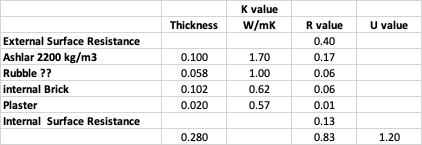-
Posts
17 -
Joined
-
Last visited
Personal Information
-
About Me
Ex water engineer & project manager - interested in domestic carbon footprint reduction
-
Location
Bath
Recent Profile Visitors
The recent visitors block is disabled and is not being shown to other users.
Geoff-Belgraver's Achievements

Member (3/5)
0
Reputation
-

U-value for Ashlar Bath Stone & brick Walls
Geoff-Belgraver replied to Geoff-Belgraver's topic in Heat Insulation
Lost has 30mm insulation -- Sorry it's 300mm - I should have checked before pressing send -

U-value for Ashlar Bath Stone & brick Walls
Geoff-Belgraver replied to Geoff-Belgraver's topic in Heat Insulation
No it's 1876 plaster ! My CH always kicks in when controlled sees that the 16 deg C internal set-pointmcy be reached - it's weather dependent, so always prevents a low internal temperature. The heating set-point time/temp is always reached. -

U-value for Ashlar Bath Stone & brick Walls
Geoff-Belgraver replied to Geoff-Belgraver's topic in Heat Insulation
Double glazing and draught-proofing resulted in at least 20% reduction CO2e Lost has 30mm insulation The suspended floors are being draught excluded with and impermeable membrane before re-carpeting. I'm prepared to find out whether the perceived wisdom re interstitial condensation is a problem. The 1st floor draughts though the floorboards showed how the loose fill between the Bath ashlar and the brick is very permeable to air movement from the basement through to the roof space at the wall plate, plus Bath stone is totally permeable and dries out very quickly. We are not listed The ASHP sizing will come out of the MCS survey. -

U-value for Ashlar Bath Stone & brick Walls
Geoff-Belgraver replied to Geoff-Belgraver's topic in Heat Insulation
If I was younger I would accept the disruption of internal insulation and on-cost, so no internal insulation will be applied. - that wouldl mean stripping off the huge skirting boards, losing part of the cornices, sorting out the window reveals, re-carpeting and decorating etc etc. So the plan is to accept the house as it is, minimise heat loss by double glazing and draught-proofing and see whether an ASHP will enable us to reduce our carbon footprint a bit further. A huge part of Bath will have to grapple with this problem as energy prices increase etc -- Bath City Council have declared a Climate Emergency, but can't help with any funding and are obstructive in our conservation area with regard to external insulation. -

U-value for Ashlar Bath Stone & brick Walls
Geoff-Belgraver replied to Geoff-Belgraver's topic in Heat Insulation
Thanks Ian Your calc is interesting - it's a higher than the one I did using the following, which is probably too low Re condensation - we've lived here for 40 years and have never had any condensation, but as I've had a real drive to reduce draughts and hence heat loss, it will be interesting to see what happens. I managed bedsits in a similar Victorian building for many years and am clear about the need to ensure adequate air-flow when the RH may cause condensation as the dew-point is reached. -
My Victorian house is built of 4" ashlar Bath stone + ~2" rubble infill + 4" brick + plaster. Does anyone have a good u-value for this construction. I need this in order to have a discussion with the surveyor when he come to do a MCS survey in a couple of weeks. He will want to use the data in https://mcscertified.com/mcs-launch-new-improved-heat-pump-calculator/
-

Window provider U-values a bit crap?
Geoff-Belgraver replied to Moonshine's topic in Heat Insulation
Not quite within this post, but for Victorian double-glazed wooden sash windows, does anyone know the ideal way to use the U-value? Should I just use the area of the sash, or include the box as well? E.g, the sashes in my office are 1.68m2 and with the boxes and timber at top & bottom they are 1.89m3 -
Yes -thermal store heat loss data from the supplier will be important and many do not even specify the type and thickness of the insulation.
-
yep - probably - that's why the MCS survey is so important (if they are up to doing the calc for the thermal store)
-
I have a good solid concrete pad at the end of the garden next to the back lane for the tank and the ASHP - it will need a 20m run of insulated pipe to the house
-
I’m sure we’ll all be on load-shifting tariffs like OtopusGo and others before long and they will all be delivered by smart meters....Whilst I don’t like the idea of replacing a simple well-tried technology with new-fangled electronics, we will miss out on load-shifting deals if we stand still. The current low-wind problems exacerbated by the problems with an interconnector and gas prices illustrate how important it will be to store kW somehow. – see how gas is used to turn up the volume as the demand increases as we all wake up https://www.energydashboard.co.uk/fourtyeight So, just to keep the idea of using an ASHP and cheap off-peak electricity and a large thermal store rolling, I have arranged for a full MCS Survey of my house to see what we can achieve for RHI purposes. See https://mcscertified.com/mcs-launch-new-improved-heat-pump-calculator/ I’m having this done free under the Flex Community scheme in Partnership with Bath & West Community Energy (BWCE) https://www.bwce.coop/about-us/ by Stemy Energy https://www.stemyenergy.co.uk who have contracted out the survey to a local ASHP installer. I've also talked at length with the MD of Stiebel-Eltron re ASHP and large domestic thermal stores and find that they are definitely not well known in the UK, but there are lots on the continent, so coupled with the MCS data, I should get a better feel for what's practical and cost effective. My best delivered price so far for a fully insulated 5000 litre thermal store is £4.4k. The payback will depend on how hot we can get if from the best ASHP at night.... Of course, once I have all the data, I could do it all with second-hand kit.
-
Geoff-Belgraver changed their profile photo
-
Joe -- what's the size of your buffer tank ?? Maybe I could use smaller tank with the immersion heater option -- I'll look at the max hourly demand for a cold evening... However I would still be operating the ASHP throughout the day and I want to make use of tariffs which will be available to any of us who can use power when the wholesale price is cheapest i.e at night - which is what Octopus are offering as a replacement for E7. A major stumbling block for me is this old Victorian House.....see another post from me
-
-
-


